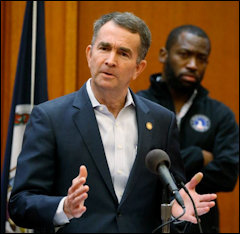This morning I was intending to compose a post critical of Governor Ralph Northam’s approach to the COVID-19 crisis. But then I read this article in the Washington Post: “Grading the region’s coronavirus response: Hogan 1st, Northam last, and Bowser in the middle.” Much against my nature, I feel compelled to defend the governor.
It is the unstated thesis of WaPo columnist Robert McCarthy that an activist approach to combating the COVID-19 virus is called for. He finds Maryland Governor Larry Hogan (R) the most praise-worthy, followed by Washington, D.C. Mayor Muriel E. Bowser (D), for being quick and aggressive in ordering measures to compel social distancing.
“One might assume that a governor who spent most of his career as a physician would be among the first to press for quick, decisive action to combat a deadly, fast-spreading infectious disease,” McCartney writes. Yet “Northam was the last of the three to close the state’s schools, order a state of emergency and seek activation of the National Guard. He still hasn’t joined Maryland and the District to order a full shutdown of on-site eating and drinking in restaurants and bars.”
And to that, I say, good for Northam.
I do fault him for several things. It appears that he has been slow to address developing shortages of hospital beds, shortages of protective gear for medical workers, and the fiscal implications of the inevitable economic contraction. But I believe that his relatively restrained curtailment of business has been appropriate. As I explained in a previous post, activist epidemic-control measures have huge costs. The benefit of slowing the spread of the coronavirus must be balanced against the costs to the economy and jobs.
First, let us note that the virus has been slower to spread in Virginia than in Maryland and D.C. (using the latest data published on the Johns Hopkins University Coronavirus Resource Center):
Washington, D.C.
Population: 630,000
COVID-19 cases: 120
One case per 5,250 population
Maryland
Population: 6.0 million
COVID-19 cases: 249
One case per 24,000 population
Virginia
Population: 8.6 million
COVID-19 cases: 221
One case per 38,900 population
Hogan and Bowser have been far more aggressive than Northam, but… the disease has spread more rapidly in Maryland and D.C., than in Virginia. Is it possible that draconian, job-killing measures really aren’t bending the curve?
Perhaps, Northam critics might say, we should be comparing Maryland and D.C. to Northern Virginia, which is part of the Washington metropolitan area. After all, there’s a lot of movement back and forth between NoVa, D.C., and Maryland.
According to Virginia Department of Health data, as of yesterday, 95 of Virginia’s confirmed COVID-19 cases originated in Northern Virginia (Alexandria 5, Arlington 26, Fairfax 31, Loudoun 15, and Prince William 18). The population of those five jurisdictions (not including the smaller independent cities) is about 2.5 million. That translates into one coronavirus case per 26,300 population — lower than Maryland!
Washington Post writers have a mystical faith in the efficacy of activist government. The more aggressive and intrusive, the better. Northam has chosen a more cautious approach than his metro Washington peers. There is no discernible evidence — certainly none that the WaPo has presented — that his approach has proven any less efficacious in slowing the spread of the disease.
Meanwhile, I’m willing to bet — time will tell — that the lighter hand of government will prove less debilitating to the economy in Virginia than in Maryland and D.C.



